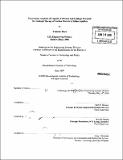| dc.contributor.advisor | Mort D. Webster and Howard Herog. | en_US |
| dc.contributor.author | Raza, Yamama | en_US |
| dc.contributor.other | Massachusetts Institute of Technology. Technology and Policy Program. | en_US |
| dc.date.accessioned | 2010-03-25T14:55:26Z | |
| dc.date.available | 2010-03-25T14:55:26Z | |
| dc.date.copyright | 2009 | en_US |
| dc.date.issued | 2009 | en_US |
| dc.identifier.uri | http://hdl.handle.net/1721.1/53063 | |
| dc.description | Thesis (S.M. in Technology and Policy)--Massachusetts Institute of Technology, Engineering Systems Division, Technology and Policy Program, 2009. | en_US |
| dc.description | Includes bibliographical references (p. 61-62). | en_US |
| dc.description.abstract | The need to address climate change has gained political momentum, and Carbon Capture and Storage (CCS) is a technology that is seen as being feasible for the mitigation of carbon dioxide emissions. However, there is considerable uncertainty that is present in our understanding of the behavior of CO₂ that is injected into the sub-surface. In this work, uncertainty analysis is performed using Monte Carlo simulations for capacity estimates and leakage potential for a saline aquifer. Six geologic parameters are treated as uncertain: porosity, irreducible water saturation, the endpoint relative permeability of CO₂, residual gas saturation, viscosity of water, and viscosity of the brine. The results of the simulations for capacity indicate that there is a large uncertainty in capacity estimates, and that evaluating the model at using the mean values of the individual parameters does not give the same result as the mean of the distribution of capacity estimates. Sensitivity analysis shows that the two parameters that contribute the most to the uncertainty in estimates are the residual gas saturation and the endpoint relative permeability of CO₂. The results for the leakage simulation suggest that while there is a non-zero probability of leakage, the cumulative amount of CO₂ that leaks is on the order of fractions of a percent of the total injected volume, suggesting that essentially all the CO₂ is trapped. Additionally, the time when leakage begins is on the order of magnitude of thousands of years, indicating that CCS has the potential to be a safe carbon mitigation option. | en_US |
| dc.description.abstract | (cont.) Any development of regulation of geologic storage and relevant policies should take uncertainty into consideration. Better understanding of the uncertainty in the science of geologic storage can influence the areas of further research, and improve the accuracy of models that are being used. Incorporating uncertainty analysis into regulatory requirements for site characterization will provide better oversight and management of injection activities. With the proper management and monitoring of sites, the establishment of proper liability regimes, accounting rules and compensation mechanisms for leakage, geologic storage can be a safe and effective carbon mitigation tool to combat climate change. | en_US |
| dc.description.statementofresponsibility | by Yamama Raza. | en_US |
| dc.format.extent | 62 p. | en_US |
| dc.language.iso | eng | en_US |
| dc.publisher | Massachusetts Institute of Technology | en_US |
| dc.rights | M.I.T. theses are protected by
copyright. They may be viewed from this source for any purpose, but
reproduction or distribution in any format is prohibited without written
permission. See provided URL for inquiries about permission. | en_US |
| dc.rights.uri | http://dspace.mit.edu/handle/1721.1/7582 | en_US |
| dc.subject | Engineering Systems Division. | en_US |
| dc.subject | Technology and Policy Program. | en_US |
| dc.title | Uncertainty analysis of capacity estimates and leakage potential for geologic storage of carbon dioxide in saline aquifers | en_US |
| dc.type | Thesis | en_US |
| dc.description.degree | S.M.in Technology and Policy | en_US |
| dc.contributor.department | Massachusetts Institute of Technology. Engineering Systems Division | |
| dc.contributor.department | Technology and Policy Program | |
| dc.identifier.oclc | 501820392 | en_US |
